By Pauline Weston Thomas for Fashion-Era.com
King James I Costume - 1603-1625
English Costume History by Dion Clayton Calthrop
This Jacobean costume history information consists of Pages 325- 340 of the chapter on the early 17th century dress in the 22 YEAR REIGN era of James the First 1603-1625 and taken from English Costume by Dion Clayton Calthrop.
The 36 page section consists of a text copy of the book ENGLISH COSTUME PAINTED & DESCRIBED BY DION CLAYTON CALTHROP. Visuals, drawings and painted fashion plates in the book have a charm of their own and are shown amid the text. The book covers both male and female dress history of over 700 years spanning the era 1066-1830.
This page is about dress in the Stuart reign of King James I 1603-1625.
For the Introduction to this book see this introduction written by Dion Clayton Calthrop. I have adjusted the images so they can be used for colouring worksheets where pupils add some costume/society facts.
My comments are in italics.
JAMES THE FIRST
Reigned twenty-two years: 1603-1625.
Born 1566. Married 1589, Anne of Denmark.
THE MEN in the jacobean era.
This couplet may give a little sketch of the man we should now see before us:
'His ruffe is set, his head set in his ruff;
His reverend trunks become him well enough.'
We are still in the times of the upstanding ruff; we are watching, like sartorial gardeners, for the droop of this linen flower. Presently this pride of man, and of woman too, will lose its bristling, super-starched air, and will hang down about the necks of the cavaliers; indeed, if we look very carefully, we see towards the end of the reign the first fruits of elegance born out of Elizabethan precision.
Now in such a matter lies the difficulty of presenting an age or a reign in an isolated chapter. In the first place, one must endeavour to show how a Carolean gentleman, meeting a man in the street, might say immediately, 'Here comes one who still affects Jacobean clothes.' Or how an Elizabethan lady might come to life, and, meeting the same man, might exclaim, 'Ah! these are evidently the new fashions.'
A MAN OF THE TIME OF JAMES I -1603-1625
He shows the merging of the Elizabethan fashion into the fashion of Charles I. The stiff doublet and the loose breeches, the plain collar, and the ribbons at the knees. On his hawking glove is a hawk, hooded and jessed.
The Jacobean Man
The Carolean gentleman would notice at first a certain air of stiffness, a certain padded arrangement, a stiff hat, a crisp ornament of feathers.
He would see that the doublet varied from his own in being more slashed, or slashed in many more degrees. He would see that it was stiffened into an artificial figure, that the little skirt of it was very orderly, that the cut of the sleeves was tight.
He would notice also that the man's hair was only half long, giving an appearance not of being grown long for beauty, but merely that it had not been cut for some time.
He would be struck with the preciseness, the correct air of the man. He would see, unless the stranger happened to be an exquisite fellow, that his shoes were plain, that the 'roses' on them were small and neat.
His trunks, he would observe, were wide and full, but stiff. Mind you, he would be regarding this man with seventeenth-century eyes - eyes which told him that he was himself an elegant, careless fellow, dressed in the best of taste and comfort - eyes which showed him that the Jacobean was a nice enough person in his dress, but old-fashioned, grandfatherly.
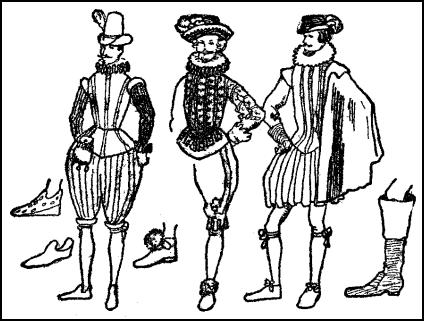
To us, meeting the pair of them, I am afraid that a certain notion we possess nowadays of cleanliness and such habits would oppress us in the company of both, despite the fact that they changed their linen on Sundays, or were supposed to do so.
And we, in our absurd clothes, with hard hats on our heads, and stiff collars tight about our necks, creases in our trousers, and some patent invention of the devil on our feet, might feel that the Jacobean gentleman looked and was untidy, to say the least of it, and had better be viewed from a distance.
To the Elizabethan lady the case would be reversed. The man would show her that the fashions for men had been modified since her day; she would see that his hair was not kept in, what she would consider, order; she would see that his ruff was smaller, and his hat brim was larger. She would, I venture to think, disapprove of him, thinking that he did not look so 'smart.'
For ourselves, I think we should distinguish him at once as a man who wore very large knickerbockers tied at the knee, and, in looking at a company of men of this time, we should be struck by the padding of these garments to a preposterous size.
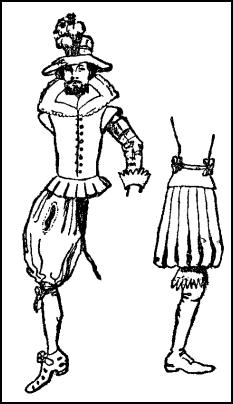
There has come into fashion a form of ruff cut square in front and tied under the chin, which can be seen in the drawings better than it can be described; indeed, the alterations in clothes are not easy to describe, except that they follow the general movement towards looseness.
The trunks have become less like pumpkins and more like loose, wide bags.
The hats, some of them stiff and hard, show in other forms an inclination to slouch.
Doublets are often made loose, and little sets of slashes appear inside the elbow of the sleeves, which will presently become one long slash in Cavalier costumes.
We have still:
'Morisco gowns, Barbarian sleeves,
Polonian shoes, with divers far fetcht trifles;
Such as the wandering English galant rifles
Strange countries for.'
But we have not, for all that, the wild extravaganza of fashions that marked the foregoing reign. Indeed, says another writer, giving us a neat picture of a man:
'His doublet is
So close and pent as if he feared one prison
Would not be strong enough to keep his soul in,
But his taylor makes another;
And trust me (for I knew it when I loved Cupid)
He does endure much pain for poor praise
Of a neat fitting suit.'
To wear something abnormally tight seems to be the condition of the world in love, from James I to David Copperfield.
Naturally, a man of the time might be riding down the street across a Scotch plaid saddle cloth and pass by a beggar dressed in clothes of Henry VIII's time, or pass a friend looking truly Elizabethan - but he would find generally that the short, swollen trunks were very little worn, and also - another point - that a number of men had taken to walking in boots, tall boots, instead of shoes.
As he rides along in his velvet cloak, his puffed and slashed doublet, his silken hose, his hands gloved with embroidered gloves, or bared to show his rings, smelling of scents, a chain about his neck, he will hear the many street cries about him:
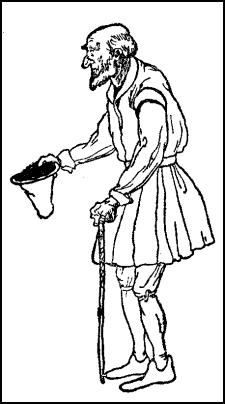
'Will you buy any sand, mistress?'
'Brooms, brooms for old shoes! Pouch-rings, boots, or buskings! Will ye buy any new brooms?'
'New oysters, new oysters! New, new cockles!'
'Fresh herrings, cockels nye!'
'Will you buy any straw?'
'Hay yee any kitchen stuff, maids?'
'Pippins fine! Cherrie ripe, ripe, ripe!'
And he will pass apprentices, most of them still in flat caps, blue doublets, and white cloth breeches and stockings, sewn all in one piece, with daggers on their backs or at their sides. And then, travelling with his man, he will come to his inn. For the life of me, though it has little to do with dress, I must give this picture of an inn from Fynes Moryson, which will do no harm, despite the fact that Sir Walter Besant quoted some of it.
At The Inn
'As soon as a passenger comes to an Inn, the servants run to him' (these would be in doublet and hose of some plain colour, with shirt-collars to the doublets turned down loose; the trunks would be wide and to the knee, and there buttoned), 'and one takes his horse and walks him till he be cool, then rubs him and gives him meat, yet I must say that they are not much to be trusted in this last point, without the eye of the Master or his servant to oversee them.
Another servant gives the passenger his private chamber, and kindles his fire, the third pulls off his boots and makes them clean' (these two servants would be wearing aprons).
'Then the Host or Hostess visits him, and if he will eat with the Host, or at a common table with the others, his meal will cost him sixpence, or in some places but fourpence, yet this course is less honourable and not used by Gentlemen; but if he will eat in his chamber' (he will retain his hat within the house), 'he commands what meats he will according to his appetite, and as much as he thinks fit for him and his company, yea, the kitchen is open to him, to command the meat to be dressed as he likes best; and when he sits at table, the Host or Hostess will accompany him, if they have many guests, will at least visit him, taking it for courtesy to be bid sit down; while he eats, if he have company especially, he shall be offered music, which he may freely take or refuse, and if he be solitary the musicians will give him good day with music in the morning.
'It is the custom and in no way disgraceful to set up part of supper for his breakfast.
'Lastly, a Man cannot more freely command at home in his own house than he may do in his Inn, and at parting if he give some few pence to the Chamberlin and Ostler they wish him a happy journey.'
Beyond this and the drawings I need say no more.
Doublet Variations
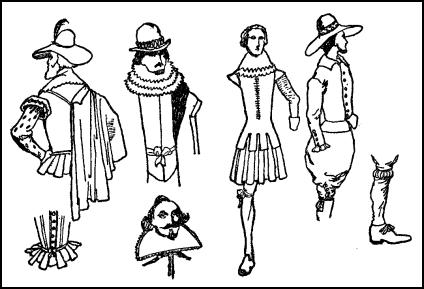
The drawings will show how the points of a doublet may be varied, the epaulette left or taken away, the little skirts cut or left plain. They show you how a hat may be feathered and the correct shape of the hat; how breeches may be left loose at the knee, or tied, or buttoned; of the frills at the wrist and the ruffs at the neck - of everything, I hope, that is necessary and useful.
THE WOMEN in Jacobean Era
'What fashion will make a woman have the best body, tailor?'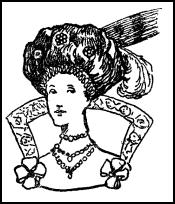
'A short Dutch waist, with a round Catherine-wheel fardingale (farthingale), a close sleeve, with a cartoose (cartridge) collar, or a pickadell.'
I think, with a little imagination, we can see the lady: add to our picture a feather fan, a man's beaver hat with a fine band round it stuck with a rose or a feather, shoes with ribbons or roses, and jewels in the hair - and I think the lady walks. Yet so difficult do I find it to lead her tripping out of the wardrobe into the world, I would remind myself of the laws for servants in this time:
'And no servant may toy with the maids under pain of fourpence.'
It is a salutary warning, and one that must be kept in the mind's eye, and as I pluck the lady from the old print, hold her by the Dutch waist, and twirl her round until the Catherine-wheel fardingale (farthingale) is a blurred circle, and the pickadell a mist of white linen, I feel, for my prying, like one who has toyed under pain of fourpence.
There are many excellent people with the true historical mind who would pick up my lady and strip her in so passionless a way as to leave her but a mass of Latin names - so many bones, tissues, and nerves - and who would then label and classify her wardrobe under so many old English and French, Dutch and Spanish names, bringing to bear weighty arguments several pages long over the derivation of the word 'cartoose' or 'pickadell,' write in notebooks of her little secret fineries, bear down on one another with thundering eloquence upon the relation of St. Catherine and her wheel upon seventeenth-century dressmaking, and so confuse and bewilder the more simple and less learned folk that we should turn away from the Eve of the seventeenth century and from the heap of clothes upon the floor no whit the wiser for all their pains.
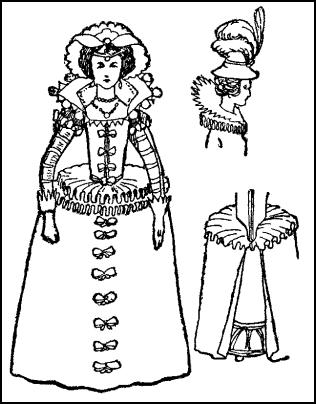
Not that I would laugh, even smile, at the diligence of these learned men who in their day puzzled the father of Tristram Shandy over the question of breeches, but, as it is in my mind impossible to disassociate the clothes and the woman, I find it difficult to follow their dissertations, however enlightening, upon Early English cross-stitch.
And now, after I have said all this, I find myself doing very nearly the same thing.
A Jacobean Lady's Wardrobe
You will find, if you look into the lady's wardrobe, that she has other fashions than the close sleeve: she has a close sleeve as an under sleeve, with a long hanging sleeve falling from the elbow; she has ruffs at her wrist of pointed lace, more cuffs than ruffs, indeed.
She does not always follow the fashion of the short Dutch waist as she has, we can see, a dress with a long waist and a tapering front to the bodice. Some dresses of hers are divided in the skirts to show a barred petticoat, or a petticoat with a broad border of embroidery.
Sometimes she is covered with little bows, and at others with much gold lacing; and now and again she wears a narrow sash round her waist tied with a bow in front.
She is taking more readily to the man's hat, feathered and banded, and in so doing is forced to dress her hair more simply and do away with jewellery on her forehead; but, as is often the case, she dresses her hair with plumes and jewels and little linen or lace ruffs, and atop of all wears a linen cap with side wings to it and a peak in the centre.
Her ruff is now, most generally, in the form of an upstanding collar to her dress, open in front, finishing on her shoulders with some neat bow or other ornament. It is of lace of very fine workmanship, edged plain and square, or in all manner of fancy scallops, circles, and points.
Sometimes she will wear both ruff and collar, the ruff underneath to prop up her collar at the back to the required modish angle. Sometimes her bodice will finish off in a double Catherine-wheel.
The Lady's Maid
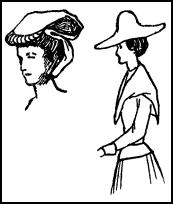 Her maid is a deal more simple; her hair is dressed very plainly, a loop by the ears, a twist at the nape of the neck. She has a shawl over her shoulders, or a broad falling collar of white linen. She has no fardingale, but her skirts are full. Her bodice fits, but is not stiffened artificially; her sleeves are tight and neat, and her cuffs plain. Upon her head is a broad-brimmed plain hat.
Her maid is a deal more simple; her hair is dressed very plainly, a loop by the ears, a twist at the nape of the neck. She has a shawl over her shoulders, or a broad falling collar of white linen. She has no fardingale, but her skirts are full. Her bodice fits, but is not stiffened artificially; her sleeves are tight and neat, and her cuffs plain. Upon her head is a broad-brimmed plain hat.
She has a piece of gossip for her mistress: at Chelsea they are making a satin dress for the Princess of Wales from Chinese silkworm's silk. On another day comes the news that the Constable of Castile when at Whitehall subscribed very handsomely to the English fashion, and kissed the Queen's hands and the cheeks of twenty ladies of honour.
The fashion for dresses of pure white, either in silk, cloth, or velvet has affected both men and women; and the countries which gave a name to the cuts of the garments are evidenced in the literature of the time. How a man's breeches or slops are Spanish; his waist, like the lady's, Dutch; his doublet French; his and her sleeves and wings on the shoulders French; their boots Polonian, cloaks German, hose Venetian, hats from everywhere. These spruce coxcombs, with looking-glasses set in their tobacco boxes, so that they may privately confer with them to see -
'How his band jumpeth with his piccadilly,
Whether his band-strings balence equally,
Which way his feather wags,'
strut along on their high-heeled shoes, and ogle any lady as she passes.
Bare Décolletage
Another fashion common to those in the high mode was to have the bodice below the ruff cut so low as to show all the breast bare, and this, together with the painting of the face, gave great offence to the more sober-minded.
The ruffs and collars of lace were starched in many colours - purple, goose-green, red and blue, yellow being completely out of the fashion since the murder of Sir Thomas Overbury by Mrs. Anne Turner, the friend of the Countess of Somerset; and this because Mrs. Turner elected to appear at the gallows in a yellow ruff.
A WOMAN OF THE TIME OF JAMES I -1603-1625

This costume plate shows a the wide fardingale, or farthingale along with its cover of the elaborate under-skirt and outer skirt.
The sleeves hang long and split to show undersleeves.
The very tall upstanding ruff or collar of lace frames the face.
As for the fardingale (farthingale), it was having its last fling.
This absurd garment had its uses once - so they say who write scandal of a Spanish Princess, and served to conceal her state upon a certain time; but when ladies forsook the fashion, they wore a loose, almost shapeless, gown, open from the waist to the feet, and a plain, unstiffened jerkin or jacket underneath.
Jacobean Costume Terms
Such a conglomeration is needed (if you remember we are looking over a lady's wardrobe) to make a lady of the time: such stuffs as rash, taffeta paropa, novats, filizetta, damask, mochado. Rash is silk and stuff, taffeta is thin silk, mochado is mock velvet.
There, again, one may fall into an antiquarian trap; whereas mochado is a manufacture of silk to imitate velvet, mokkadoe is a woollen cloth, and so on; there is no end to it.
Still, some may read and ask themselves what is a rebatoe.
It is the collar-like ruff worn at this time.
In this medley of things we shall see purles, falles, squares, buskes, tires, fans, palisadoes (this is a wire to hold the hair next to the first or duchess knot), puffs, ruffs, partlets, frislets, fillets, pendulets, bracelets, busk-points, shoe-ties, shoe roses, bongrace bonnets, and whalebone wheels - Eve!
All this, for what purpose? To turn out one of those extraordinary creatures with a cart-wheel round the middle of their persons.
As the reign died, so did its fashions die also: padded breeches lost some of their bombast, ruffs much of their starch, and fardingales much of their circumference, and the lady became more Elizabethan in appearance, wore a roll under her hair in front, and a small hood with a jewelled frontlet on her forehead. It was the last of the Tudor dress, and came, as the last flicker of a candle, before the new mode, Fashion's next footstep.
The Jacobeans JAMES THE FIRST
Reigned twenty-two years: 1603-1625. Born 1566. Married 1589, Anne of Denmark.
This Jacobean costume history information consists of Pages 341-355 of the chapter on the early 17th and mid 17th century dress in the 22 YEAR REIGN era of James the First 1603-1625 and taken from English Costume by Dion Clayton Calthrop.
The 36 page section consists of a text copy of the book ENGLISH COSTUME PAINTED & DESCRIBED BY DION CLAYTON CALTHROP. Visuals, drawings and painted fashion plates in the book have a charm of their own and are shown amid the text. The book covers both male and female dress history of over 700 years spanning the era 1066-1830.
This page is about dress in the Stuart reign of King James I 1603-1625.
For the Introduction to this book see this introduction written by Dion Clayton Calthrop. I have adjusted the images so they can be used for colouring worksheets where pupils add some costume/society facts.
My comments are in italics.
You have been reading English Costume History at www.fashion-era.com © from the chapter Stuart King James I 1603-1625, from Dion Clayton Calthrop's book English Costume.
Page Added 16 August 2010. Ref:-807.